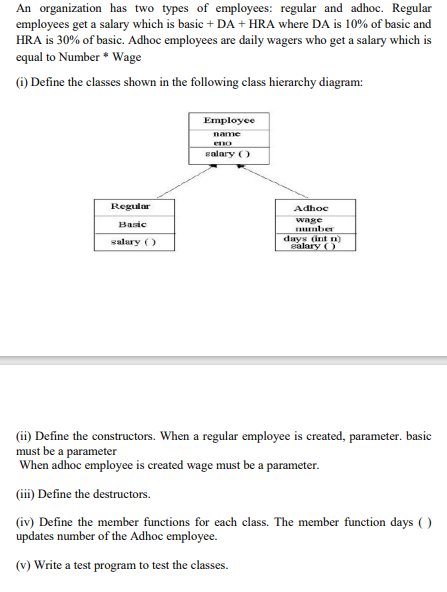An organization has two types of employees: regular and adhoc. Regular employees get a salary which is basic + DA + HRA where DA is 10% of basic and HRA is 30% of basic. Adhoc employees are daily wagers who get a salary which is equal to Number * Wage 1) Define the classes shown in the following class hierarchy diagram: Employee name salary ) Regular Adhoe wage Tnber days (int n) alary O Bante valury () (ii) Define the constructors. When a regular employee is created, parameter. basic must be a parameter When adhoc employee is created wage must be a parameter. (iii) Define the destructors. (iv) Define the member functions for each class. The member function days ( ) updates number of the Adhoc employee. (v) Write a test program to test the classes.
An organization has two types of employees: regular and adhoc. Regular employees get a salary which is basic + DA + HRA where DA is 10% of basic and HRA is 30% of basic. Adhoc employees are daily wagers who get a salary which is equal to Number * Wage 1) Define the classes shown in the following class hierarchy diagram: Employee name salary ) Regular Adhoe wage Tnber days (int n) alary O Bante valury () (ii) Define the constructors. When a regular employee is created, parameter. basic must be a parameter When adhoc employee is created wage must be a parameter. (iii) Define the destructors. (iv) Define the member functions for each class. The member function days ( ) updates number of the Adhoc employee. (v) Write a test program to test the classes.
C++ Programming: From Problem Analysis to Program Design
8th Edition
ISBN:9781337102087
Author:D. S. Malik
Publisher:D. S. Malik
Chapter10: Classes And Data Abstraction
Section: Chapter Questions
Problem 10PE
Related questions
Concept explainers
OOPs
In today's technology-driven world, computer programming skills are in high demand. The object-oriented programming (OOP) approach is very much useful while designing and maintaining software programs. Object-oriented programming (OOP) is a basic programming paradigm that almost every developer has used at some stage in their career.
Constructor
The easiest way to think of a constructor in object-oriented programming (OOP) languages is:
Question

Transcribed Image Text:An organization has two types of employees: regular and adhoc. Regular
employees get a salary which is basic + DA + HRA where DA is 10% of basic and
HRA is 30% of basic. Adhoc employees are daily wagers who get a salary which is
equal to Number * Wage
) Define the classes shown in the following class hierarchy diagram:
Employee
name
eno
salary )
Regular
Adhoc
wage
mber
days (int n)
salary ()
Basic
salary ()
(ii) Define the constructors. When a regular employee is created, parameter. basic
must be a parameter
When adhoc employee is created wage must be a parameter.
(ii) Define the destructors.
(iv) Define the member functions for each class. The member function days ( )
updates number of the Adhoc employee.
(v) Write a test program to test the classes.
Expert Solution
This question has been solved!
Explore an expertly crafted, step-by-step solution for a thorough understanding of key concepts.
This is a popular solution!
Trending now
This is a popular solution!
Step by step
Solved in 2 steps with 1 images

Knowledge Booster
Learn more about
Need a deep-dive on the concept behind this application? Look no further. Learn more about this topic, computer-science and related others by exploring similar questions and additional content below.Recommended textbooks for you

C++ Programming: From Problem Analysis to Program…
Computer Science
ISBN:
9781337102087
Author:
D. S. Malik
Publisher:
Cengage Learning

Programming Logic & Design Comprehensive
Computer Science
ISBN:
9781337669405
Author:
FARRELL
Publisher:
Cengage

C++ Programming: From Problem Analysis to Program…
Computer Science
ISBN:
9781337102087
Author:
D. S. Malik
Publisher:
Cengage Learning

Programming Logic & Design Comprehensive
Computer Science
ISBN:
9781337669405
Author:
FARRELL
Publisher:
Cengage